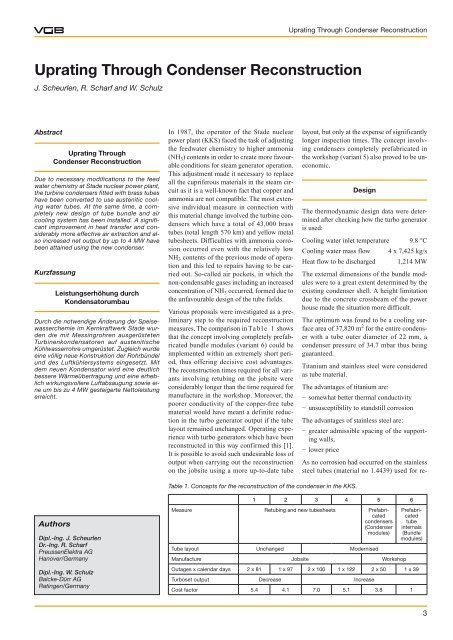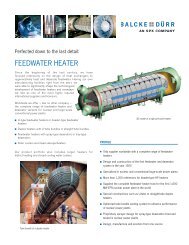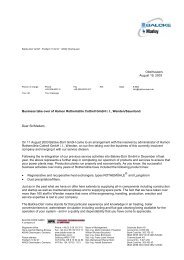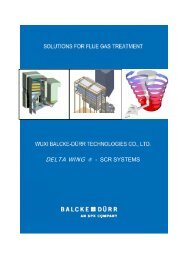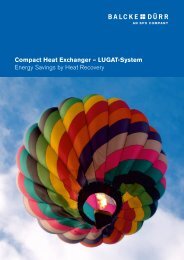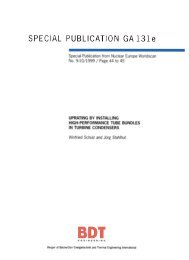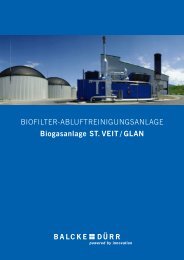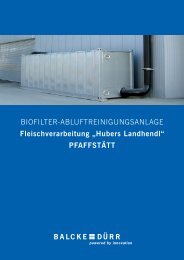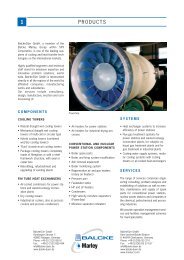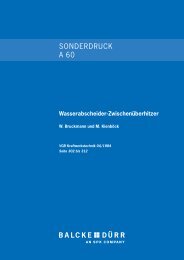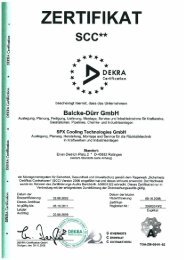Uprating Through Condenser Reconstruction - Balcke-Dürr ...
Uprating Through Condenser Reconstruction - Balcke-Dürr ...
Uprating Through Condenser Reconstruction - Balcke-Dürr ...
Create successful ePaper yourself
Turn your PDF publications into a flip-book with our unique Google optimized e-Paper software.
<strong>Uprating</strong> <strong>Through</strong> <strong>Condenser</strong> <strong>Reconstruction</strong><br />
<strong>Uprating</strong> <strong>Through</strong> <strong>Condenser</strong> <strong>Reconstruction</strong><br />
J. Scheurlen, R. Scharf and W. Schulz<br />
Abstract<br />
<strong>Uprating</strong> <strong>Through</strong><br />
<strong>Condenser</strong> <strong>Reconstruction</strong><br />
Due to necessary modifications to the feed<br />
water chemistry at Stade nuclear power plant,<br />
the turbine condensers fitted with brass tubes<br />
have been converted to use austenitic cooling<br />
water tubes. At the same time, a completely<br />
new design of tube bundle and air<br />
cooling system has been installed. A significant<br />
improvement in heat transfer and considerably<br />
more effective air extraction and also<br />
increased net output by up to 4 MW have<br />
been attained using the new condenser.<br />
Kurzfassung<br />
Authors<br />
Leistungserhöhung durch<br />
Kondensatorumbau<br />
Durch die notwendige Änderung der Speisewasserchemie<br />
im Kernkraftwerk Stade wurden<br />
die mit Messingrohren ausgerüsteten<br />
Turbinenkondensatoren auf austenitische<br />
Kühlwasserrohre umgerüstet. Zugleich wurde<br />
eine völlig neue Konstruktion der Rohrbündel<br />
und des Luftkühlersystems eingesetzt. Mit<br />
dem neuen Kondensator wird eine deutlich<br />
bessere Wärmeübertragung und eine erheblich<br />
wirkungsvollere Luftabsaugung sowie eine<br />
um bis zu 4 MW gesteigerte Nettoleistung<br />
erreicht.<br />
Dipl.-Ing. J. Scheurlen<br />
Dr.-Ing. R. Scharf<br />
PreussenElektra AG<br />
Hanover/Germany<br />
Dipl.-Ing. W. Schulz<br />
<strong>Balcke</strong>-<strong>Dürr</strong> AG<br />
Ratingen/Germany<br />
In 1987, the operator of the Stade nuclear<br />
power plant (KKS) faced the task of adjusting<br />
the feedwater chemistry to higher ammonia<br />
(NH3) contents in order to create more favourable<br />
conditions for steam generator operation.<br />
This adjustment made it necessary to replace<br />
all the cupriferous materials in the steam circuit<br />
as it is a well-known fact that copper and<br />
ammonia are not compatible. The most extensive<br />
individual measure in connection with<br />
this material change involved the turbine condensers<br />
which have a total of 43,000 brass<br />
tubes (total length 570 km) and yellow metal<br />
tubesheets. Difficulties with ammonia corrosion<br />
occurred even with the relatively low<br />
NH3 contents of the previous mode of operation<br />
and this led to repairs having to be carried<br />
out. So-called air pockets, in which the<br />
non-condensable gases including an increased<br />
concentration of NH3 occurred, formed due to<br />
the unfavourable design of the tube fields.<br />
Various proposals were investigated as a preliminary<br />
step to the required reconstruction<br />
measures. The comparison in Ta b l e 1 shows<br />
that the concept involving completely prefabricated<br />
bundle modules (variant 6) could be<br />
implemented within an extremely short period,<br />
thus offering decisive cost advantages.<br />
The reconstruction times required for all variants<br />
involving retubing on the jobsite were<br />
considerably longer than the time required for<br />
manufacture in the workshop. Moreover, the<br />
poorer conductivity of the copper-free tube<br />
material would have meant a definite reduction<br />
in the turbo generator output if the tube<br />
layout remained unchanged. Operating experience<br />
with turbo generators which have been<br />
reconstructed in this way confirmed this [1].<br />
It is possible to avoid such undesirable loss of<br />
output when carrying out the reconstruction<br />
on the jobsite using a more up-to-date tube<br />
Table 1. Concepts for the reconstruction of the condenser in the KKS.<br />
layout, but only at the expense of significantly<br />
longer inspection times. The concept involving<br />
condensers completely prefabricated in<br />
the workshop (variant 5) also proved to be uneconomic.<br />
Design<br />
The thermodynamic design data were determined<br />
after checking how the turbo generator<br />
is used:<br />
Cooling water inlet temperature 9.8 °C<br />
Cooling water mass flow 4 x 7,425 kg/s<br />
Heat flow to be discharged 1,214 MW<br />
The external dimensions of the bundle modules<br />
were to a great extent determined by the<br />
existing condenser shell. A height limitation<br />
due to the concrete crossbeam of the power<br />
house made the situation more difficult.<br />
The optimum was found to be a cooling surface<br />
area of 37,820 m2 for the entire condenser<br />
with a tube outer diameter of 22 mm, a<br />
condenser pressure of 34.7 mbar thus being<br />
guaranteed.<br />
Titanium and stainless steel were considered<br />
as tube material.<br />
The advantages of titanium are:<br />
− somewhat better thermal conductivity<br />
− unsusceptibility to standstill corrosion<br />
The advantages of stainless steel are:<br />
− greater admissible spacing of the supporting<br />
walls,<br />
− lower price<br />
As no corrosion had occurred on the stainless<br />
steel tubes (material no 1.4439) used for re-<br />
1 2 3 4 5 6<br />
Measure Retubing and new tubesheets Prefabricated<br />
condensers<br />
(<strong>Condenser</strong><br />
modules)<br />
Tube layout Unchanged Modernised<br />
Manufacture Jobsite Workshop<br />
Prefabricated<br />
tube<br />
internals<br />
(Bundle<br />
modules)<br />
Outages x calendar days 2 x 81 1 x 97 2 x 100 1 x 122 2 x 50 1 x 39<br />
Turboset output Decrease Increase<br />
Cost factor 5.4 4.1 7.0 5.1 3.8 1<br />
3


